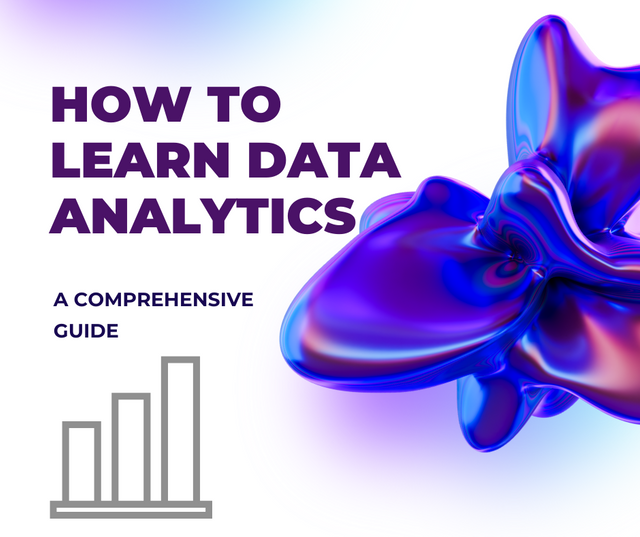Data analytics has become an essential skill in today's data-driven world. From businesses making data-informed decisions to researchers extracting valuable insights, the demand for professionals with data analytics expertise is on the rise. If you're looking to embark on a journey, this comprehensive guide on ‘How to Learn Data Analytics‘ will help you get started and progress effectively in this exciting field.

Why Learn Data Analytics?
Learning data analytics can be immensely beneficial for several reasons:
High Demand for Data Analysts
The job market for data analysts is booming. Companies across industries are actively seeking professionals who can analyze data to help them make data-driven decisions.
Lucrative Salaries
Data analysts are often well-compensated for their skills. Salaries can vary depending on experience and location, but they generally offer a competitive income.
Diverse Career Opportunities
Data analytics skills are versatile and can be applied in various fields, including finance, healthcare, marketing, e-commerce, and more. This versatility opens up a wide range of career options.
Impactful Insights
By learning data analytics, you can uncover valuable insights that can lead to improvements in products, services, and processes. These insights can drive innovation and success in organizations.
Prerequisites for Learning Data Analytics
Before diving into data analytics, it's essential to have a solid foundation in certain areas:
Mathematics and Statistics: Data analytics heavily relies on mathematical concepts such as probability, calculus, and linear algebra. A strong grasp of statistics is also crucial for data analysis.
Programming Skills: You should be comfortable with at least one programming language commonly used in data analytics, such as Python or R. These languages are essential for data manipulation and analysis.
Data Visualization: Understanding data visualization tools and techniques is essential for effectively communicating your findings. Tools like Tableau, Power BI, or Python libraries like Matplotlib and Seaborn are valuable.
Critical Thinking: Data analytics involves problem-solving and critical thinking. You should be able to formulate hypotheses, design experiments, and interpret results.
Curiosity: Curiosity is a key trait for a data analyst. Being curious about data and its potential insights will drive your motivation to learn and explore.
Steps to Learn Data Analytics
To become proficient in data analytics, follow these steps:
Set Clear Goals
Define your objectives and goals. What do you want to achieve with data analytics? Are you interested in a particular industry or type of analysis? Setting clear goals will help you stay focused.
Choose the Right Tools and Technologies
Select the tools and technologies you want to work with. Python and R are popular programming languages, while tools like Excel, SQL, and various data visualization platforms are commonly used in data analytics.
Learn Statistics and Mathematics
Brush up on your math and statistics skills. Resources like online courses, textbooks, or tutorials can help you understand key concepts.
Master Data Visualization
Effective data visualization is essential for conveying your insights. Explore different visualization techniques and tools to become proficient in this area.
Practice with Real Data
Apply what you've learned by working on real-world datasets. Websites like Kaggle offer datasets and competitions that allow you to practice your skills.
Online Courses and Resources
There is a plethora of online courses and resources available to help you learn data analytics. Here are some popular platforms and options: Coursera, edX, Udacity, Syntax Technologies, Blogs and Forums, and YouTube.
Books on Data Analytics
In addition to online courses, consider reading books on data analytics to deepen your understanding. Some highly recommended books include:
• "Python for Data Analysis" by Wes McKinney
• "Data Science for Business" by Foster Provost and Tom Fawcett
• "The Art of Data Science" by Roger D. Peng
• "Data Points" by Nathan Yau
Join Data Analytics Communities
Being part of data analytics communities can provide valuable support, networking opportunities, and insights. Join online forums, LinkedIn groups, and attend local meetups or conferences if possible.
Hands-On Projects
Hands-on projects are a crucial part of your learning journey. Apply your knowledge to real-world problems, create your datasets, and build projects to showcase your skills.
Build a Portfolio
As you complete projects, create a portfolio showcasing your work. A strong portfolio can impress potential employers or clients when you're seeking job opportunities or freelance work.
Networking and Career Opportunities
Networking is vital in the data analytics field. Attend industry events, connect with professionals on LinkedIn, and seek internships or entry-level positions to gain practical experience.
Conclusion
Learning data analytics is a rewarding journey that opens doors to diverse career opportunities. With determination, the right resources, and continuous practice, you can become a proficient data analyst. Remember to set clear goals, build a strong foundation in mathematics and statistics, explore different tools and technologies, and apply your knowledge through hands-on projects.
Stay curious, network with fellow data enthusiasts, and don't be afraid to tackle challenges along the way. Data analytics is a dynamic field, and your ability to adapt and learn will be your greatest asset. Whether you're looking to advance your career or embark on a new one, the world of data analytics awaits your exploration. Start your journey today and unlock the power of data-driven insights.